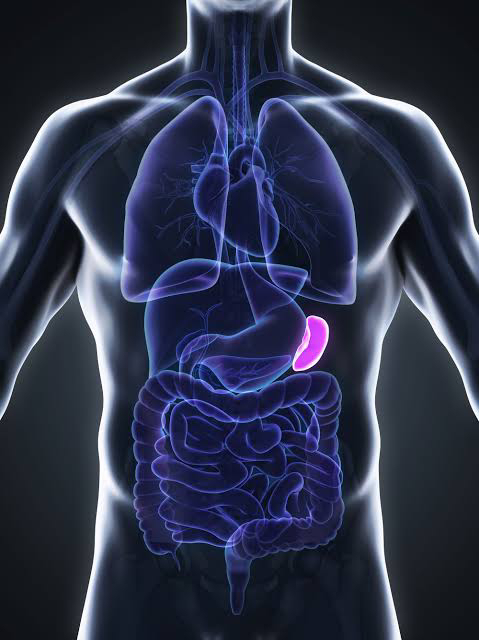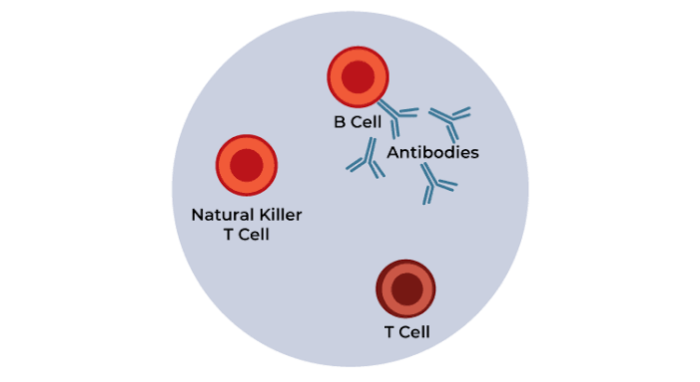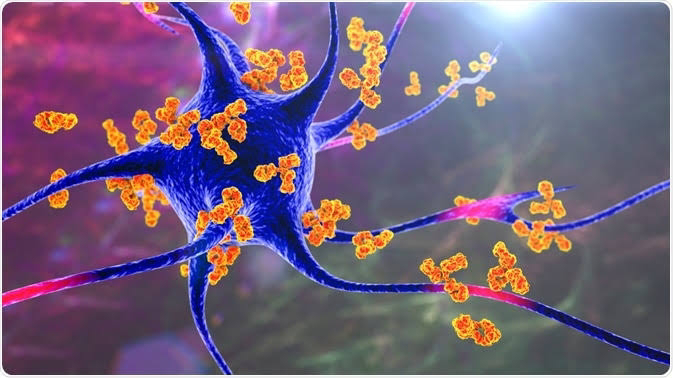Immune System
Immunity is our body's way of protecting us from harmful things like germs. When germs like bacteria, viruses, or fungi try to invade our body, our immune system kicks in to fight them off. It does this by recognizing these invaders as foreign and attacking them. Our immune system also remembers these invaders, so if they try to attack us again, it can fight them off more easily. This is why once we get sick from a specific germ, like the flu virus, we usually don't get sick from that same germ again because our immune system knows how to defeat it.
Our immune system is like our body's defense mechanism. It's made up of special cells, proteins, tissues, and organs that work together to protect us from germs and other harmful invaders. The immune system has several key functions:
- Recognition: It can recognize a wide variety of pathogens, such as viruses, bacteria, fungi, and parasites, as well as abnormal cells like cancer cells. This recognition is based on the unique molecules (antigens) on the surface of these invaders.
- Response: Upon recognizing a pathogen or abnormal cell, the immune system mounts a response to eliminate it.
- Memory: One of the most remarkable features of the immune system is its ability to remember past encounters with pathogens. This memory allows for a faster and more effective response upon re-exposure to the same pathogen.
- Regulation: The immune system is finely balanced to prevent excessive responses that could harm the body. Specialized cells and molecules help regulate the immune response to maintain this balance.
- Protection: Overall, the immune system plays a crucial role in protecting the body from infections and diseases. It's a complex network that works tirelessly to keep us healthy.
Cells of Immune system
The immune system is made up of various types of cells, each with a specific job in protecting the body from diseases and other harmful substances. Here are some of the main immunological cells:
1. White Blood Cells (WBCs) or Leukocytes : White blood cells, also called leukocytes, are like superheroes inside our bodies. They protect us from germs and help us stay healthy. They are part of our immune system, which is like our body's defense team. When germs try to make us sick, white blood cells work hard to find and destroy them. There are different types of white blood cells, each with its own special job. They include -
- Neutrophils: These are the most common type of white blood cells and are often the first responders to infections. They engulf and destroy bacteria and fungi.
- Lymphocytes: There are two main types of lymphocytes: B cells and T cells. B cells produce antibodies that can neutralize bacteria and viruses, while T cells directly destroy infected or abnormal cells.
- Monocytes: These are large white blood cells that help to engulf and digest bacteria, viruses, dead cells, and other debris in the bloodstream.
- Eosinophils: These white blood cells are involved in allergic reactions and help to fight off parasitic infections.
- Basophils: Basophils release histamine and other chemicals that help to increase blood flow to an injured area and promote inflammation, which is a key part of the body's immune response.
2. B cells or B lymphocytes: B cells originate in the bone marrow and mature in the spleen. They are responsible for producing antibodies, roteins that recognise and neutrakise specific pathogens. B cells also have memory, which allows them to recall previous intruders and respond more swiftly if they recur. This memory contributes to long-lasting protection against some diseases.
3. T cells or T lymphocytes: T cells are produced in the bone marrow and matures in the thymus and play a crucial role in immunity. They can directly attack infected cells and coordinate immune responses. There are different types of T cells, each with its own function. Some T cells directly attack infected or abnormal cells, while others help regulate the immune response. T cells are able to recognize specific invaders, such as viruses or bacteria, and work together to coordinate a targeted attack, protecting the body from harm.
4. Natural killer cells or NK cells: Natural killer (NK) cells are the body's frontline defense against infected and cancerous cells. NK cells release toxic chemicals that cause the targeted cell to die. Unlike other immune cells, NK cells don't need to recognize specific markers on the target cell's surface. This makes them fast and effective at killing dangerous cells. NK cells also help regulate the immune response by producing signaling molecules that influence other immune cells. Overall, NK cells play a crucial role in keeping the body healthy.
5. Dendritic cells: Dendritic cells function as immunological messengers. They patrol tissues, looking for invaders such as bacteria and viruses. When they locate something worrisome, they take a bit of it (an antigen) and hurry to the next lymph node. They present the antigen to T cells, which function as the immune system's generals. This presentation enables T cells to recognize the intruder and conduct a focused response. Dendritic cells also influence how strong the immune response should be, balancing combating the infection with avoiding damage to the body's own tissues.
6. Macrophages: Macrophages are like the cleaners of the body, roaming around to find and engulf harmful things like bacteria, viruses, and even dead cells. Once they've swallowed up these bad guys, they break them down and get rid of them. Macrophages also help out by alerting the rest of the immune system when there's trouble. They're important for healing, too, because they can stimulate the growth of new tissue.
7. Phagocytes: Phagocytes are essential for keeping us healthy by fighting off infections and cleaning up debris. They also send signals to other immune cells, helping coordinate the body's defense. Without phagocytes, we would be much more vulnerable to illnesses and infections.
Organs of Immune system
The immune system is made up of many organs, tissues, and cells that work together to defend the body against dangerous invaders including bacteria, viruses, fungi, and parasites. The immune system's key organs are as follows:
1. Primary lymphoid organs: These are where immune cells are produced and mature. The primary lymphoid organs include the bone marrow and the thymus gland.
2. Scondary lymphoid organs: These are where immune responses are initiated. The secondary lymphoid organs include the lymph nodes, spleen, tonsils, and mucosa-associated lymphoid tissues (MALT), such as the gut-associated lymphoid tissue (GALT), bronchus-associated lymphoid tissue (BALT), and nasopharynx-associated lymphoid tissue (NALT).
3. Bone marrow: Bone marrow is a soft, spongy tissue found in the center of bones. Bone marrow produces three types of blood cells: red blood cells, which carry oxygen; white blood cells, which fight infections; and platelets, which help blood clot. These cells are crucial for keeping you healthy and fighting off diseases. Bone marrow also contains stem cells, which can turn into different types of blood cells.
4. Thymus: Thymus is a small organ located in the chest, behind your breastbone. It plays a crucial role in your immune system, especially when you're young. The thymus helps to produce and mature a type of white blood cell called T cells, which are important for fighting infections and diseases. As you grow older, the thymus gradually shrinks and is replaced by fat, but it continues to play a role in immune function.
5. Lymph nodes: Lymph nodes are small, bean-shaped structures located throughout the body, primarily along the lymphatic vessels. They act as filters, trapping and destroying pathogens and other harmful substances.
6. Spleen: The spleen is located in the upper left part of the abdomen, beneath the ribcage. It acts as a filter for blood, removing old or damaged red blood cells and helping to fight infections.
7. Tonsils: Tonsils are small masses of lymphoid tissue located at the back of the throat. They help to trap and remove pathogens that enter the body through the mouth and nose.
8. MALT (Mucosa-associated lymphoid tissue): MALT is a diffuse system of small concentrations of lymphoid tissue found in various mucous membranes throughout the body, such as the gastrointestinal tract, respiratory tract, and urogenital tract. MALT helps to protect against infections at mucosal surfaces.
Types of Immune system
The immune system is a complex network of cells, tissues, and organs that work together to defend the body against harmful pathogens, such as bacteria, viruses, and parasites. There are two main types of immune responses:
Innate immunity - The innate immune system serves as the body's initial line of defense against intruders. It reacts in the same way to all pathogens and foreign chemicals, which is why it is also known as the "non-specific" immune system. It functions swiftly; for example, it detects and destroys bacteria that have entered the skin through a minor wound within a few hours. But the innate immune system cannot always prevent pathogens from spreading. Innate immunity also helps to alert the adaptive immune system, which is more specialized, to come and join the fight. This system doesn't provide long-lasting protection, but it's crucial for keeping us healthy and fighting off infections every day.
Innate immunity includes physical Barriers, such as skin and mucous membranes that act as physical barriers which prevent pathogens from entering the body. These barriers are reinforced by substances like mucus and stomach acid, which trap or kill pathogens. It also includes cellular components like Phagocytes, such as macrophages and neutrophils, that are specialized immune cells that engulf and destroy pathogens. They also help to remove dead cells and debris from the body.
Adaptive immunity - The adaptive immune system is a more specialized defense mechanism that develops throughout life and provides targeted protection against specific pathogens. If the innate (generic) immune system fails to eliminate pathogens, the adaptive (specialized) immune system takes control. The adaptive immune system is particular to the type of germ causing the infection. To do so, however, it must first detect the germ as such. This implies it takes longer to respond than the innate immune system, but it responds more accurately. It has the added benefit of being able to "remember" pathogens. So, the next time the adaptive immune system encounters a pathogen it has already encountered, it will be able to attack it more quickly. The adaptive immune system may take a few days to respond the first time it encounters the pathogen, but the body can react promptly the second time.
The adaptive immune system is made up of:
- T cells in the tissue between the body's cells
- B cells (also in the tissue between the body's cells)
- Antibodies in the blood and other bodily fluids
In adaptive immune system, B cells produce antibodies that can bind to specific pathogens, marking them for destruction by other immune cells. T cells can directly destroy infected cells or help regulate the immune response. Antibodies, also known as immunoglobulins, play a crucial role in the adaptive immune system by recognizing and neutralizing pathogens. So, the adaptive immune system is a highly specialized and dynamic defense system that provides the body with long-term protection against specific pathogens.
Autoimmunity
Autoimmunity is when the immune system mistakenly attacks healthy cells in the body, thinking they are harmful. Normally, the immune system protects the body from infections and diseases. However, in autoimmunity, this defense system becomes confused and starts to attack its own tissues. This can lead to inflammation, pain, and damage to organs. A hyper active immune system can cause a lot of disorders in our body. Some of them includes:
- Type 1 diabetes or juvenile diabetes
- Multiple sclerosis
- Rheumatoid arthritis
- Hemolytic anemia
- Grave's disease















Comments
Post a Comment